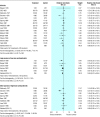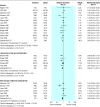Corticosteroids for severe sepsis and septic shock: a systematic review and meta-analysis
- PMID: 15289273
- PMCID: PMC515196
- DOI: 10.1136/bmj.38181.482222.55
Corticosteroids for severe sepsis and septic shock: a systematic review and meta-analysis
Abstract
Objective: To assess the effects of corticosteroids on mortality in patients with severe sepsis and septic shock.
Data sources: Randomised and quasi-randomised trials of corticosteroids versus placebo (or supportive treatment alone) retrieved from the Cochrane infectious diseases group's trials register, the Cochrane central register of controlled trials, Medline, Embase, and LILACS.
Review method: Two pairs of reviewers agreed on eligibility of trials. One reviewer entered data on to the computer and four reviewers checked them. We obtained some missing data from authors of trials and assessed methodological quality of trials.
Results: 16/23 trials (n = 2063) were selected. Corticosteroids did not change 28 day mortality (15 trials, n = 2022; relative risk 0.92, 95% confidence interval 0.75 to 1.14) or hospital mortality (13 trials, n = 1418; 0.89, 0.71 to 1.11). There was significant heterogeneity. Subgroup analysis on long courses (> or = 5 days) with low dose (< or = 300 mg hydrocortisone or equivalent) corticosteroids showed no more heterogeneity. The relative risk for mortality was 0.80 at 28 days (five trials, n = 465; 0.67 to 0.95) and 0.83 at hospital discharge (five trials, n = 465, 0.71 to 0.97). Use of corticosteroids reduced mortality in intensive care units (four trials, n = 425, 0.83, 0.70 to 0.97), increased shock reversal at 7 days (four trials, n = 425; 1.60, 1.27 to 2.03) and 28 days (four trials, n = 425, 1.26, 1.04 to 1.52) without inducing side effects.
Conclusions: For all trials, regardless of duration of treatment and dose, use of corticosteroids did not significantly affect mortality. With long courses of low doses of corticosteroids, however, mortality at 28 days and hospital morality was reduced.
Figures





Comment in
-
Review: low-dose but not high-dose corticosteroids reduced all-cause mortality in severe sepsis and septic shock.ACP J Club. 2005 Mar-Apr;142(2):30. ACP J Club. 2005. PMID: 15739977 No abstract available.
References
-
- Angus D, Linde-Zwirble WT, Lidicker J, Clermont G, Carcillo J, Pinsky MR. Epidemiology of severe sepsis in the United States: analysis of incidence, outcome, and associated costs of care. Crit Care Med 2001;29: 1303-10. - PubMed
-
- Rangel-Frausto MS, Pittet D, Hwang T, Woolson RF, Wenzel RP. The dynamics of disease progression in sepsis: Markov modeling describing the natural history and the likely impact of effective antisepsis agents. Clin Infec Dis 1998;27: 185-90. - PubMed
-
- Annane D, Aegerter P, Jars-Guincestre MC, Guidet B. Current epidemiology of septic shock: the CUB-Réa Network. Am J Resp Crit Care Med 2003;168: 165-72. - PubMed
-
- Annane D, Cavaillon JM. Corticosteroids in sepsis: from bench to bedside? Shock 2003;20: 197-207. - PubMed
-
- Annane D, Sébille V, Troché G, Raphael JC, Gajdos P, Bellissant E. A 3-level prognostic classification in septic shock based on cortisol levels and cortisol response to corticotrophin. JAMA 2000;283: 1038-45. - PubMed
Publication types
MeSH terms
Substances
LinkOut - more resources
Full Text Sources
Other Literature Sources
Medical
